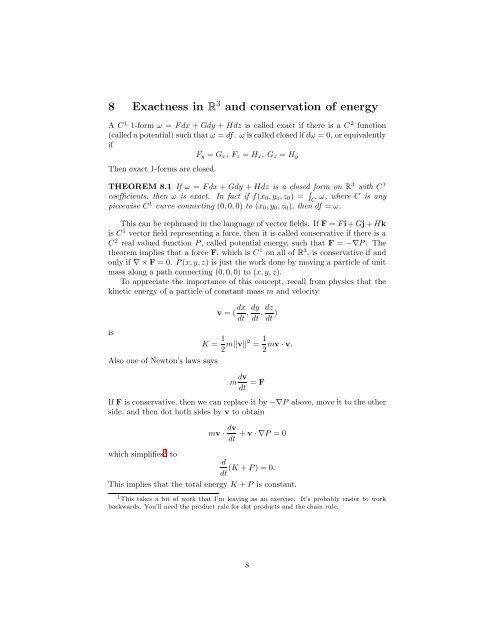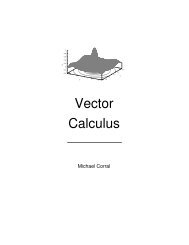Introduction to differential forms
Introduction to differential forms
Introduction to differential forms
Create successful ePaper yourself
Turn your PDF publications into a flip-book with our unique Google optimized e-Paper software.
8 Exactness in R 3 and conservation of energy<br />
A C 1 1-form ω = F dx + Gdy + Hdz is called exact if there is a C 2 function<br />
(called a potential) such that ω = df. ω is called closed if dω = 0, or equivalently<br />
if<br />
F y = G x , F z = H x , G z = H y<br />
Then exact 1-<strong>forms</strong> are closed.<br />
THEOREM 8.1 If ω = F dx + Gdy + Hdz is a closed form on R 3 with C 1<br />
coefficients, then ω is exact. In fact if f(x 0 , y o , z 0 ) = ∫ ω, where C is any<br />
C<br />
piecewise C 1 curve connecting (0, 0, 0) <strong>to</strong> (x 0 , y 0 , z 0 ), then df = ω.<br />
This can be rephrased in the language of vec<strong>to</strong>r fields. If F = F i + Gj + Hk<br />
is C 1 vec<strong>to</strong>r field representing a force, then it is called conservative if there is a<br />
C 2 real valued function P , called potential energy, such that F = −∇P . The<br />
theorem implies that a force F, which is C 1 on all of R 3 , is conservative if and<br />
only if ∇ × F = 0. P (x, y, z) is just the work done by moving a particle of unit<br />
mass along a path connecting (0, 0, 0) <strong>to</strong> (x, y, z).<br />
To appreciate the importance of this concept, recall from physics that the<br />
kinetic energy of a particle of constant mass m and velocity<br />
is<br />
v = ( dx<br />
dt , dy<br />
dt , dz<br />
dt )<br />
K = 1 2 m||v||2 = 1 mv · v.<br />
2<br />
Also one of New<strong>to</strong>n’s laws says<br />
m dv<br />
dt = F<br />
If F is conservative, then we can replace it by −∇P above, move it <strong>to</strong> the other<br />
side, and then dot both sides by v <strong>to</strong> obtain<br />
mv · dv<br />
dt + v · ∇P = 0<br />
which simplifies 1 <strong>to</strong><br />
d<br />
(K + P ) = 0.<br />
dt<br />
This implies that the <strong>to</strong>tal energy K + P is constant.<br />
1 This takes a bit of work that I’m leaving as an exercise. It’s probably easier <strong>to</strong> work<br />
backwards. You’ll need the product rule for dot products and the chain rule.<br />
8








